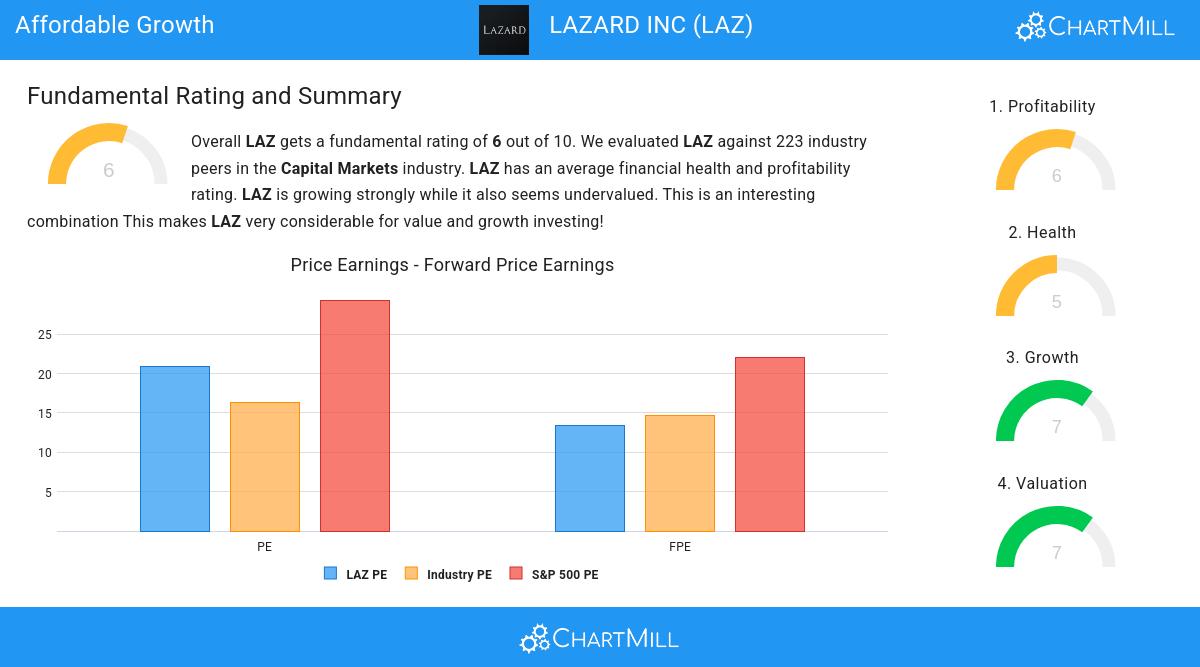For those who appreciate growth without the sticker shock, LAZARD INC (NYSE:LAZ) is worth considering.
By Mill Chart
Last update: Mar 10, 2025
LAZARD INC (NYSE:LAZ) has caught the eye of our stock screener as an affordable growth stock. NYSE:LAZ is displaying robust growth metrics and also excels in terms of profitability, solvency, and liquidity. Additionally, it appears to be reasonably priced. Let's delve into the details.

Exploring NYSE:LAZ's Growth
Every stock receives a Growth Rating from ChartMill, ranging from 0 to 10. This rating assesses various growth aspects, including historical and projected EPS and revenue growth. NYSE:LAZ boasts a 7 out of 10:
- The Earnings Per Share has grown by an impressive 216.22% over the past year.
- LAZ shows a strong growth in Revenue. In the last year, the Revenue has grown by 20.94%.
- The Earnings Per Share is expected to grow by 31.51% on average over the next years. This is a very strong growth
- LAZ is expected to show quite a strong growth in Revenue. In the coming years, the Revenue will grow by 10.71% yearly.
- When comparing the EPS growth rate of the last years to the growth rate of the upcoming years, we see that the growth is accelerating.
- The Revenue growth rate is accelerating: in the next years the growth will be better than in the last years.
Valuation Insights: NYSE:LAZ
ChartMill employs its own Valuation Rating system for all stocks. This score, ranging from 0 to 10, is determined by evaluating different valuation factors, including price to earnings and free cash flow, both in absolute terms and relative to the market and industry. NYSE:LAZ has earned a 7 for valuation:
- Compared to an average S&P500 Price/Earnings ratio of 29.35, LAZ is valued a bit cheaper.
- When comparing the Price/Forward Earnings ratio of LAZ to the average of the S&P500 Index (22.10), we can say LAZ is valued slightly cheaper.
- Compared to the rest of the industry, the Enterprise Value to EBITDA ratio of LAZ indicates a rather cheap valuation: LAZ is cheaper than 82.96% of the companies listed in the same industry.
- Based on the Price/Free Cash Flow ratio, LAZ is valued cheaper than 80.72% of the companies in the same industry.
- LAZ's low PEG Ratio(NY), which compensates the Price/Earnings for growth, indicates a rather cheap valuation of the company.
- The decent profitability rating of LAZ may justify a higher PE ratio.
- A more expensive valuation may be justified as LAZ's earnings are expected to grow with 31.51% in the coming years.
Unpacking NYSE:LAZ's Health Rating
ChartMill employs a unique Health Rating system for all stocks. This rating, ranging from 0 to 10, is determined by analyzing various liquidity and solvency ratios. For NYSE:LAZ, the assigned 5 for health provides valuable insights:
- With a decent Altman-Z score value of 2.36, LAZ is doing good in the industry, outperforming 74.89% of the companies in the same industry.
- The Debt to FCF ratio of LAZ is 2.98, which is a good value as it means it would take LAZ, 2.98 years of fcf income to pay off all of its debts.
- LAZ's Debt to FCF ratio of 2.98 is fine compared to the rest of the industry. LAZ outperforms 75.34% of its industry peers.
Profitability Analysis for NYSE:LAZ
ChartMill assigns a proprietary Profitability Rating to each stock. The score is computed by evaluating various profitability ratios and margins and ranges from 0 to 10. NYSE:LAZ was assigned a score of 6 for profitability:
- LAZ's Return On Assets of 5.70% is fine compared to the rest of the industry. LAZ outperforms 70.40% of its industry peers.
- LAZ has a better Return On Equity (42.91%) than 97.76% of its industry peers.
- With an excellent Return On Invested Capital value of 10.37%, LAZ belongs to the best of the industry, outperforming 84.30% of the companies in the same industry.
- The 3 year average ROIC (6.49%) for LAZ is below the current ROIC(10.37%), indicating increased profibility in the last year.
- The Gross Margin of LAZ (93.82%) is better than 93.72% of its industry peers.
Every day, new Affordable Growth stocks can be found on ChartMill in our Affordable Growth screener.
For an up to date full fundamental analysis you can check the fundamental report of LAZ
Disclaimer
This is not investing advice! The article highlights some of the observations at the time of writing, but you should always make your own analysis and invest based on your own insights.



